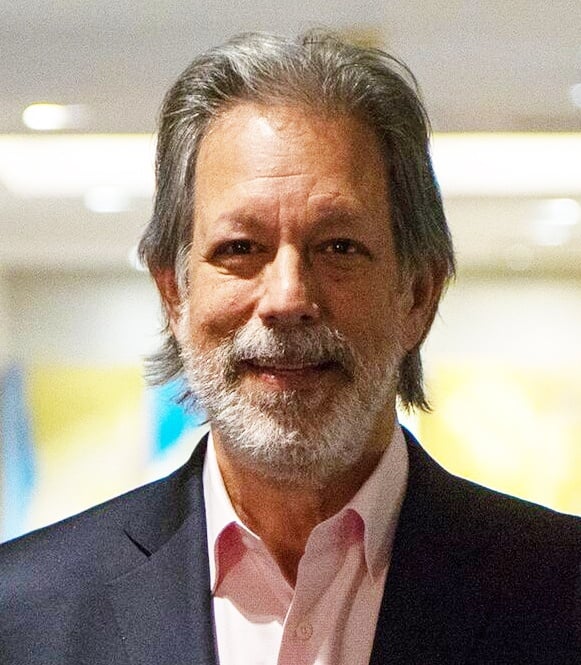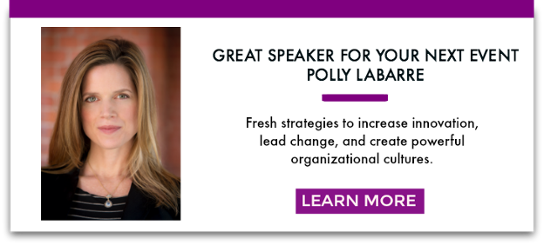New Paths to Organizational Control: Polly LaBarre, Top Innovation Speaker
The natural reaction to the Wells Fargo debacle, perhaps within that company and by leaders at other companies looking to prevent similar behavior, is to clamp down and exert more rules and regulations; tighten organizational control. But Management Lab partner POLLY LaBARRE cautions that approach runs the risk of stifling the very innovation and employee engagement that organizations covet.
Polly has been a top innovation speaker since her early days at Fast Company magazine; someone whose approach to organizational control was centered around the idea of unleashing the full power and creativity of the people within it by demolishing bureaucracy. Polly's strategies look to make organizations as human as the people who comprise them.
I asked Polly to write about the tug between controlling, regulating, and making rules vs. the ideal of setting workers free to find new ways to drive innovation. I hope you enjoy her thoughts here on a fresh approach to organizational control.
---------------------------------------------------------
Control by Other Means - The Benefits of Bureaucracy Without All the Costs by Polly LaBarre
It was one of the most breathtakingly egregious cases of institutional overreach in recent memory: the widespread fraud uncovered at Wells Fargo last fall. Under bruising pressure to meet wildly aggressive sales targets, thousands of bankers created as many as 2 million accounts for customers without their consent—and kept the racket alive for years with a web of shady practices and tacit executive support.
Not surprisingly, the scandal generated waves of outrage, congressional hearings, hundreds of millions in penalties, a dramatic clawback of $75 million in executive compensation, and the “early retirement” of leaders implicated in the scam. A scathing (and frequently self-serving) report commissioned by the independent directors of the board and prepared by law firm Shearman & Sterling, pins the blame squarely on the toxic mix of aggressive sales goals and the bank’s “decentralized organizational structure.” The word “decentralized” and its variants pop up dozens of times in the report, underscoring the diagnosis: the delegation of decision making and risk taking to the edges of the organization.
The obvious (in the estimation of the board) remedy: more centralized control. Along with swapping out the leadership, eliminating sales goals, and rethinking incentive compensation, a centerpiece of the response is the “centralization of control functions.”
While this reaction is entirely predictable—all financial institutions require clear guardrails and strong, shared practices when it comes to risk management—it raises a question: is more control and more centralization really the answer? What has tight, centralized control done for financial institutions, or any other organization for that matter? Has it shielded them from scandal? Has it safeguarded them from crisis? Has it fortified them to thrive in the midst of increasing complexity and disruption? Has it instilled a deeply-felt sense of morality and ethical values?
You don’t have to dig deep to find the answers to those questions. Exhibit A: 2008, Bear Sterns, Lehman Brothers, AIG, TARP, need I go on?
Here’s the thing: the ruling ideology of virtually every large-scale organization is Controllism—controlling people, controlling information, controlling deviations from the norm. AKA Bureaucracy: a management technology invented over a century ago to enable organizations to operate efficiently at scale—to maximize standardization, specialization, predictability, and control.
The problem is, we live in a world where efficiency is important, but it’s just table stakes. The challenge for every organization today is to become ever more adaptable, innovative, and inspiring. Yet, the organizational virtues—standardization, specialization, formalization, hierarchy, alignment, conformance—that underlie the bureaucratic management model are particularly toxic to innovation and adaptability. For example, organizational silos blind people to “white space” opportunities and make it difficult to creatively recombine resources across the organization. Or, a top-down authority structure tends to overweight the opinions of senior leaders whose emotional equity is invested in the past. And, a culture that overvalues compliance discourages people from sharing new ideas and challenging the status quo.
As a result, organizations ruled by those principles become ever more inertial, incremental, and uninspiring—a cluster of disabilities we call “Bureausclerosis” at the MLab.
Now, this doesn’t mean those efficiency principles are optional—it doesn’t mean they’re not critical. The new question is: how do you get all of the advantages of large-scale organization—the control and coordination, the discipline, the leverage to do complex things at scale—without all of the costs (the drag on agility, the damper on ingenuity, the shackles on human potential which my colleagues at the MLab estimate add up to a staggering $3 trillion in lost economic output.)
How do you transcend the inevitable trade-offs between: size and agility, efficiency and innovation, discipline and engagement?
By separating the WHAT from the HOW. In most organizations, the way you get control, discipline, efficiency, reliability, alignment (the “what”) is through mechanisms like detailed procedures, close supervision, strict spending limits, highly prescriptive job roles, discretion that dwindles with distance from the head office.
Now, imagine a bank, say, with 12,000 associates and 850 branches spread across five countries. That bank has just three layers of management. Operating decisions are almost entirely decentralized: each branch makes its own loan decisions, sets its own pricing on loans and deposits, controls its own marketing budget, runs its own website, and serves all customer segments in its area. Those branch employees have no sales or activity targets. There are no centralized call centers (when you call the bank an actual human from your neighborhood actually picks up!). And all support and HQ functions are negotiated via an internal marketplace that keeps costs down and value added high.
This isn’t a fantasy scenario. That bank is Stockholm-based Svenksa Handelsbanken and it is the most profitable bank in Europe with the highest levels of customer satisfaction and loyalty. Handelsbanken has outperformed its peers’ return on equity for forty-four years running. It has industry-beating cost efficiency and loan loss ratios—and it has logged a stunning 167% return since the 2008 financial crisis. And more: following the crisis, Handelsbanken took no write-offs, no state support or state guarantees as so many of its peers did. All of this with a radically decentralized management model that pushes decision-making authority into the hands of branch managers and their teams.
SUPPLEMENTAL READING:
Polly LaBarre – How Mavericks are Changing the Game of Business and
Polly LaBarre: 3 Strategies for Creating a Culture of Everyday, Everywhere Experimentation
This doesn’t mean that there’s NO control at Handelsbanken—just control by other means. Individual and branch autonomy at the bank is supported by: 1) a non-negotiable credit policy; 2) a near-obsessive focus on cultivating rich, human, local relationships with customers; and 3) access to transparent, granular, real-time performance data (every branch manager has a dashboard of metrics—from cost-to-income ratio, to ROE, to profit per employee, to customer satisfaction numbers).
A small set of crystal-clear, simple rules. Deeply felt, widely held shared values. Sunlight and peer pressure. Three forms of regulation that work together to unleash, rather than squash, human initiative, ingenuity, and passion. The result: Handelsbanken is more profitable, more productive, more agile, more engaging, and more risk-proof than its peers.
Virtue can’t be regulated—but it can be woven into the warp and weft of an organization to make it infinitely more resilient.
ABOUT POLLY LABARRE: AUTHOR, CONSULTANT & SPEAKER
POLLY LABARRE is a partner at Management Lab, a global management consulting firm, a writer, and popular keynote speaker. Polly has been committed to helping organizations become more resilient, innovative, and inspiring since her days as founding member at Fast Company magazine. She is co-author of the bestselling book Mavericks at Work: Why the Most Original Minds in Business Win which has been published in 16 languages. Polly's fresh organizational and leadership strategies embolden and equip leaders at every level to make a meaningful impact and lead change in their organizations. Polly has a reputation as a top speaker on leadership, organizational culture, innovation and change.
About Tony D'Amelio
Tony has spent his career putting talented people and audiences together, first in the music business and later representing the world's leading speakers. After concluding 27 years as Executive Vice President of the Washington Speakers Bureau, Tony launched D'Amelio Network, a boutique firm that manages the speaking activities of a select group of experts on business, management, politics and current events. Clients include: Mike Abrashoff, Mariana Atencio, Chris Barton, Lisa Bodell, Geoff Colvin, Daryl Davis, Suneel Gupta, Ron Insana, Katty Kay, Polly LaBarre, Nicole Malachowski, Ken Schmidt, and Bob Woodward.

.png)

.jpg)

